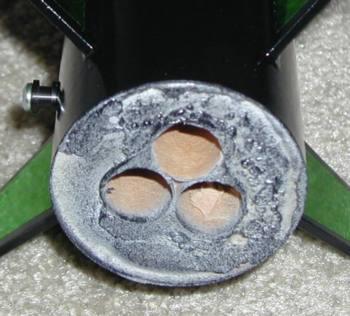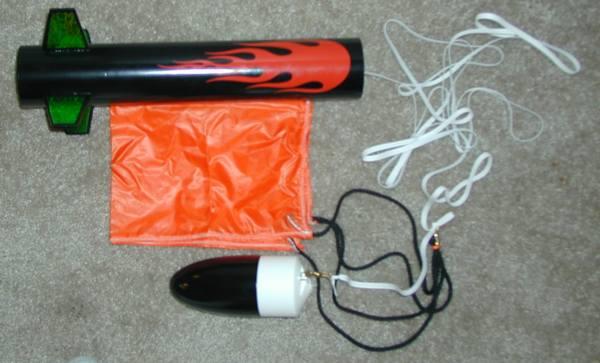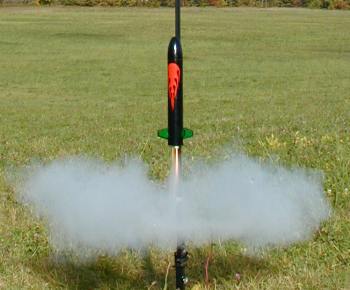| Construction Rating: | starstarstarstar_borderstar_border |
| Flight Rating: | starstarstarstarstar_border |
| Overall Rating: | starstarstarstarstar_border |
| Manufacturer: | Cycline3 |
I first learned about Cycline3 when a review was submitted to EMRR. It has been a while since you could get a kit since the owner, Sean Rose was in China. But this summer I was able to purchase the 001 - Fun Fat Rocket. You, no doubt, know why I picked it. It is a "stubby" rocket.
The Fun Fat Rocket is a bit more though, because it is also a 3x18mm motor cluster. Cycline3 appears to sell (or have sold) this rocket in two other configurations, 2x24mm and 1x24mm as well.
I've added this rocket to my Comparison Article. See my 2.6" Stubby Rocket Comparison Page
 The rocket kit includes a 2.6" airframe that is 14.25" long. It uses a plastic nose cone which is the same as an Estes Fat Boy. It comes with a 1/8" balsa sheet that the 4 fins are cut out from. It also comes with 3 18mm motor tubes, some card stock (index cards) for the centering rings, a 12 foot, 1/4" wide, elastic shock cord, a brass swivel and rail buttons. It also comes with a nylon parachute and a vinyl "flame" decal.
The rocket kit includes a 2.6" airframe that is 14.25" long. It uses a plastic nose cone which is the same as an Estes Fat Boy. It comes with a 1/8" balsa sheet that the 4 fins are cut out from. It also comes with 3 18mm motor tubes, some card stock (index cards) for the centering rings, a 12 foot, 1/4" wide, elastic shock cord, a brass swivel and rail buttons. It also comes with a nylon parachute and a vinyl "flame" decal.
CONSTRUCTION:
The instructions are printed on 4 pages of 8½ x 11" paper. In addition there is a cover page with black-and-white photos of the rocket and a cardstock template and fin alignment guide. The instructions include some photos to assist in the construction. Cycline3 calls this a level 3 kit. The assembly of the kit is actually very easy, however, the techniques push this kit to level 3 or higher. Cycline3 instructs you to be prepared with four types of glue. Wood glue, CA, epoxy and polyurethane glue. The polyurethane glue plays a very large role in this kit's assembly and Cycline3 says, "You CANNOT build this kit without polyurethane glue".
So building the Fun Fat Rocket was interesting because it brought an entirely new technique to my attention. Let's start with that technique. Also note, that I used Gorilla Glue for my polyurethane glue. (additional comments about Polyurethane glue)
The Fun Fat Rocket does not include wooden centering rings. That's right, here you have a 3x18mm motor mount and no centering rings. What you have is a template that allows you to cut out two cardstock (index cards) centering rings. These thin rings are attached to the motor mounts with wood glue which is more or less to hold them in place. It isn't even all that important if there are small gaps in the fit. Once they are in place, a small bead of polyurethane glue is put around the joints. For those that have not used polyurethane glue before there are several things to consider: 1) it is sticky and very messy when wet, 2) it expands when drying, and 3) it is easily chipped, cut, or sanded after it is dry. Cycline3 specifically counts on the fact that it expands.
So once, you have prepared the motor mount the instructions tell you to put a bead of polyurethane glue 1/2" inside the bottom of the airframe and then put a 1/8" layer of polyurethane glue on the upper centering ring. This is then slid into the airframe and set aside, standing vertically, to dry. Be sure to put this on a piece of wax paper since some glue will seep out. My experience is that this amount of glue and specifically this kind of glue takes 24 hours to fully dry. While drying you will be able to observe it expanding and filling the gap between the 18mm motor tubes and inside of the airframe. Cycline3 says is makes a "honeycomb". They also say it will be the "lightest mount you've ever made" but also indicates that is "strong".
 Once the upper centering ring is formed with the polyurethane glue, the rocket is flipped over and you put 1/16" to 1/8" of glue on the bottom centering ring, completely covering it, and allow it to expand and dry completely. Again, and I can't stress this enough, set this on a piece of wax paper and leave it alone for at least 24 hours! Notice how it will look (after some primer and paint overspray) in the picture to the left.
Once the upper centering ring is formed with the polyurethane glue, the rocket is flipped over and you put 1/16" to 1/8" of glue on the bottom centering ring, completely covering it, and allow it to expand and dry completely. Again, and I can't stress this enough, set this on a piece of wax paper and leave it alone for at least 24 hours! Notice how it will look (after some primer and paint overspray) in the picture to the left.
Next the tube is marked with the marking guide and the fins are attached. Nothing fancy here, except Cycline3 wants you to use CA to attach the fin and to use epoxy or wood glue to make the fillets. I used wood glue.
Cycline3 includes a pair of Matt's Rail Buttons, which is a nice add (at least to me). These are attached using a 1/8" drill bit, a screwdriver and some CA. I didn't attach mine when the instructions said to prior to finishing. I have always attached my rail buttons after finishing to make finishing easier.
The recovery system is done via the 3-fold paper method. This greatly disappointed me. The primary reason for disappointment is because this is a cluster. What does this have to do with it? Well, my experience with Estes motor clusters is that all the ejection charges do not go at once and therefore after the first one pushes the wadding and 'chute out, the others can have a negative impact on the exposed elastic (at the mount). Perhaps this could be reduced by putting a piece of wadding in each motor tube before installing the motor. The other way is to use a Kevlar® to elastic mount. The rest of the recovery system is great.

Cycline3 gives some guidance for finishing the rocket and promotes using "gloss spray polyurethane" to coat the rockets instead of "clear acrylic". They indicate that the polyurethane does not yellow over time.
I finished my rocket by first using several coats of Plasti-Kote Primer. I then painted it with Krylon Gloss Black. After it dried a day, I applied the vinyl "flame" decal that came with the kit. The decal is very nice. It would be great to see more decals, other than just the flame, but I was happy to have that. If you haven't worked with vinyl decals in the past, be sure to read Cycline3's instructions closely. I also added Book Covers, etc. Prismatic Green Book Cover to each of the fins.
Cycline3 gives continued warnings throughout the build of this rocket about not modifying the motor mount, using CA for the fins, and avoiding epoxy. Cycline3 gives the following warning, "It is the modeler's responsibility to ensure proper center of gravity/center of pressure relationship. Depending on how the modeler follows the directions and what adhesives are used (please use the recommended adhesive in each step), as well as the reload of motor used, nosecone weight may need to be added. Please fly safely." With all this, one would expect Cycline to identify where the CG should be! I adhered to all these requirements, but once I RockSIM'd this kit and used my finished weight and center of gravity (CG) I had to add 1 ounce of nose weight to fly on B's and C's. I did this using clay and pushed it up into the nose cone.
Overall, for CONSTRUCTION I would rate this kit 3 ½ points. I applaud Cycline3 for the interesting centering ring method. I foresee myself using something like this for some scratch-builds. The technique is a bit messy and will cause some to have issues. The rest of the build is very easy. I think Cycline3 included a nice recovery system (parachute, 12' elastic, and swivel) with the exception of the mount. The instructions are good for those with experience and the decal is very nice.
 FLIGHT/RECOVERY:
FLIGHT/RECOVERY:
Cycline3 recommends the A8-3 or B6-4 for the first flight and calls the C6-7 their "favorite".
Cycline3 doesn't give an expected finish weight or CG (as mentioned above). This kit is sensitive to build techniques to have stability so I think these two specs should be provided. My Fun Fat Rocket specs are: 6.2 ounces with a empty CG at 8.5" from the nose cone.
Flight preparation requires wadding. I attached a piece of Nomex® heat shield. The parachute, called a "Frankenchute" only once in the instructions is very easy to fold since it is not round, hexagonal, nor octagonal. It is a rectangle. I really like this parachute!
Motor preparation requires that you make a small masking tape thrust ring on each motor. There are instructions for this task, but it is easy and works without issue. You then need to friction fit the motor so that it doesn't kick out upon ejection.
My first flight was on three A8-3's. They all lit. The flight was up and down so quickly that I barely had stood up after taking a lift-off picture!
Next I loaded up three B6-4's. Now, this was much better. Had enough altitude to see the whole flight, see a slightly early ejection (heard the three charges) and then to see a nice descent. Cycline3 has sized their parachute for this kit just right. The flight was very straight and, with the three motors, fun to watch.
Having a perfectly calm day, I followed the progression in motors. I went to three C6-5's. This seemed to be okay based on RockSIM, but in hindsight, my observation of the B6-4's should have pushed me to the C6-7's. Nonetheless, three C6-5's were loaded. Again all three lit and the rocket took off fast and straight. Again, ejection was early and the 7 second delay would have been better. Again, I heard all three charges... pop, pop, pop! Recovery was good and the rocket is in great shape.

After three flights I closely inspected the shock cord mount. The elastic is showing some signs of drying out. This can be seen when it is stretched. I figure another 3 flights and I will have to do something.
For FLIGHT/RECOVERY, I would rate this rocket 4 ½ points. The parachute is excellent. The flights on B's and C's are excellent. The motor mount is solid. This is fun rocket on the field and gets a bit of attention because it looks like an extended Estes Fat Boy (which essentially it is).
I give the rocket an OVERALL rating of 4 points. Building this kit was good experience and I learned a new technique. That is always fun. With the attention given to the length of shockcord, parachute and motor mount technique, I would have liked to see attention given to the shockcord mount. Once finished the rocket gives nice flights and looks good.
It should also be noted that a free CD with QuickTime movies came with the kit. These are various rockets at WVSOAR launches. They are a nice bonus. One in particular was inspirational to me, because I have always felt a rocket video made to Orff's Carmina Burana would be awesome and Sean did just that. I would love to see one with the rocket launches timed to the peaks in the music though and so I've decided to work on one. Oh, what is Orff's Carmina Burana? I first heard it in the movie Excalibur, but have heard it in other movies recently as well.
 |
 |